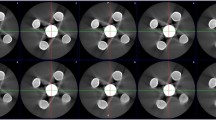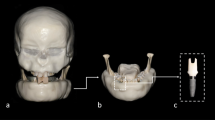Abstract
Objective
To compare the expression of the volumetric alteration (VA) artifact between cylindrical and convex triangular fields of view (FOVs) using high-density materials in different positions in two cone-beam computed tomography (CBCT) devices.
Materials and methods
Cylinders of five high-density materials (amalgam, chromium-cobalt, gutta-percha, titanium, and zirconium) with known physical volume were individually submitted to CBCT acquisition in four positions inside a polymethylmethacrylate phantom using two different FOV shapes (convex triangular and cylindrical) on the Veraviewepocs® R100 (R100) and Veraview® X800 (X800) devices. Two oral radiologists obtained the tomographic volumes by segmenting each cylinder. The difference between the tomographic and physical volumes corresponded to the VA. These values were analyzed by intraclass correlation coefficient and analysis of variance for repeated measures with Tukey post hoc test (α = 5%).
Results
The FOV influenced the VA only in the X800 device (p = 0.014): the VA in the triangular FOV was greater than in the cylindrical FOV. The VA in the triangular FOV of the X800 device was greater than the R100 device (p < 0.0001). The material influenced the expression of the VA only in the R100 device (p < 0.0001); gutta-percha presented the highest VA, being underestimated, and differing from the other materials (p < 0.01).
Conclusion
The triangular FOV increased the VA of high-density materials in the X800 device.
Clinical relevance
It is important to know if there is an influence on the volumetric alteration artifact of dental materials due to the different image formation geometry in the convex triangular FOV.



Similar content being viewed by others
References
Pauwels R, Araki K, Siewerdsen JH, Thongvigitmanee SS (2015) Technical aspects of dental CBCT: state of the art. Dentomaxillofac Radiol 44:20140224. https://doi.org/10.1259/dmfr.20140224
Gaêta-Araujo H, Alzoubi T, Vasconcelos KF, Orhan K, Pauwels R, Casselman JW, Jacobs R (2020) Cone-beam computed tomography in dentomaxillofacial radiology: a two-decade overview. Dentomaxillofac Radiol 49:20200145. https://doi.org/10.1259/dmfr.20200145
Schulze R, Heil U, Gross D, Bruellmann DD, Dranischnikow E, Schwanecke U, Schoemer E (2011) Artefacts in CBCT: a review. Dentomaxillofac Radiol 40:265–273. https://doi.org/10.1259/dmfr/30642039
Jaju PP, Jain M, Singh A, Gupta A (2013) Artefacts in cone beam CT. Open J Stomatol 3:292–297. https://doi.org/10.4236/ojst.2013.35049
Draenert FG, Coppenrath E, Herzog P, Müller S, Mueller-Lisse UG (2007) Beam hardening artefacts occur in dental implant scans with the NewTom cone beam CT but not with the dental 4-row multidetector CT. Dentomaxillofac Radiol 36:198–203. https://doi.org/10.1259/dmfr/32579161
Schulze R, Heil U, Berndt D, d’Hoedt B (2010) On cone-beam computed tomography artifacts induced by titanium implants. Clin Oral Implants Res 21:100–107. https://doi.org/10.1111/j.1600-0501.2009.01817.x
Celikten B, Jacobs R, deFaria Vasconcelos KF, Huang Y, Nicolielo LFP, Orhan K (2017) Assessment of volumetric distortion artifact in filled root canals using different cone-beam computed tomographic devices. J Endod 43:1517–1521. https://doi.org/10.1016/j.joen.2017.03.035
Codari M, de Faria VK, Ferreira Pinheiro Nicolielo L, Haiter Neto F, Jacobs R (2017) Quantitative evaluation of metal artifacts using different CBCT devices, high-density materials and field of views. Clin Oral Implants Res 28:1509–1514. https://doi.org/10.1111/clr.13019
Vanderstuyft T, Tarce M, Sanaan B, Jacobs R, de Faria VK, Quirynen M (2019) Inaccuracy of buccal bone thickness estimation on cone-beam CT due to implant blooming: an ex-vivo study. J Clin Periodontol 46:1134–1143. https://doi.org/10.1111/jcpe.13183
Coelho-Silva F, Martins LAC, Braga DA, Zandonade E, Haiter-Neto F, de-Azevedo-Vaz SL (2020) Influence of windowing and metal artefact reduction algorithms on the volumetric dimensions of five different high-density materials: a cone-beam CT study. Dentomaxillofacial Radiol 49:20200039. https://doi.org/10.1259/dmfr.20200039
de Faria VK, Queiroz PM, Codari M, Pinheiro Nicolielo LF, Freitas DQ, Jacobs R, Haiter-Neto F (2020) A quantitative analysis of metal artifact reduction algorithm performance in volume correction with 3 CBCT devices. Oral Surg Oral Med Oral Pathol Oral Radiol 130:328–335. https://doi.org/10.1016/j.oooo.2020.03.049
Vasconcelos KF, Nicolielo LF, Nascimento MC, Haiter-Neto F, Bóscolo FN, Van Dessel J, EzEldeen M, Lambrichts I, Jacobs R (2015) Artefact expression associated with several cone-beam computed tomographic machines when imaging root filled teeth. Int Endod J 48:994–1000. https://doi.org/10.1111/iej.12395
Suetens P (2009) Fundamentals of medical imaging. Cambridge Univ Press, New York
Rottke D, Dreger J, Sawada K, Honda K, Schulze D (2019) Comparison of manual and dose reduction modes of a MORITA R100 CBCT. Dentomaxillofac Radiol 48:20180009. https://doi.org/10.1259/dmfr.20180009
Martins LAC, Queiroz PM, Nejaim Y, Vasconcelos KF, Groppo FC, Haiter-Neto F (2020) Evaluation of metal artefacts for two CBCT devices with a new dental arch phantom. Dentomaxillofac Radiol 49:20190385. https://doi.org/10.1259/dmfr.20190385
Yushkevich PA, Piven J, Hazlett HC, Smith RG, Ho S, Gee JC, Gerig G (2006) User-guided 3D active contour segmentation of anatomical structures: significantly improved efficiency and reliability. Neuroimage 31:1116–1128. https://doi.org/10.1016/j.neuroimage.2006.01.015
Scarfe WC, Farman AG (2008) What is cone-beam CT and how does it work? Dent Clin North Am 52:707–730. https://doi.org/10.1016/j.cden.2008.05.005
Maret D, Telmon N, Peters OA, Lepage B, Treil J, Inglèse JM, Peyre A, Kahn JL, Sixou M (2012) Effect of voxel size on the accuracy of 3D reconstructions with cone beam CT. Dentomaxillofacial Radiol 41:649–655. https://doi.org/10.1259/dmfr/81804525
Ye N, Jian F, Xue J, Wang S, Liao L, Huang W, Yang X, Zhou Y, Lai W, Li J, Wang J (2012) Accuracy of in-vitro tooth volumetric measurements from cone-beam computed tomography. Am J Orthod Dentofac Orthop 142:879–887. https://doi.org/10.1016/j.ajodo.2012.05.020
Coelho-Silva F, Gaêta-Araujo H, Rosado LPL, Freitas DQ, Haiter-Neto F, de-Azevedo-Vaz SL (2021) Distortion or magnification? An in vitro cone-beam CT study of dimensional changes of objects with different compositions. Dentomaxillofac Radiol :20210063. https://doi.org/10.1259/dmfr.20210063.
Ferreira LM, Visconti MAPG, Nascimento HA, Dallemolle RR, Ambrosano GM, Freitas DQ (2015) Influence of CBCT enhancement filters on diagnosis of vertical root fractures: a simulation study in endodontically treated teeth with and without intracanal posts. Dentomaxillofac Radiol 44:20140352. https://doi.org/10.1259/dmfr.20140352
Chang E, Lam E, Shah P, Azarpazhooh A (2016) Cone-beam computed tomography for detecting vertical root fractures in endodontically treated teeth: a systematic review. J Endod 42:177–185. https://doi.org/10.1016/j.joen.2015.10.005
Yamamoto-Silva FP, de Oliveira Siqueira CF, Silva MAGS, Fonseca RB, Santos AA, Estrela C, de Freitas Silva BS (2018) Influence of voxel size on cone-beam computed tomography-based detection of vertical root fractures in the presence of intracanal metallic posts. Imaging Sci Dent 48:177–184. https://doi.org/10.5624/isd.2018.48.3.177
Rodrigues CT, Jacobs R, Vasconcelos KF, Lambrechts P, Rubira-Bullen IRF, Gaêta-Araujo H, Oliveira-Santos C, Duarte MAH (2021) Influence of CBCT-based volumetric distortion and beam hardening artefacts on the assessment of root canal filling quality in isthmus-containing molars. Dentomaxillofac Radiol 20200503. https://doi.org/10.1259/dmfr.20200503
Acknowledgements
The first author is grateful to the University of Costa Rica for funding his postgraduate studies. Special thanks to the Oral Radiology Section of the Faculty of Dentistry of the University of Costa Rica for the support during image acquisition with the Veraviewepocs® R100 device, and to Dr. Ana Luisa Berrocal Domínguez for her support during image acquisition with the Veraview® X800 device.
The authors thank Espaço da Escrita—Pró—Reitoria de Pesquisa—UNICAMP—for the language services, and S.I.N Implantes for providing the titanium cylinders.
Funding
This study was financed in part by the Coordenação de Aperfeiçoamento de Pessoal de Nível Superior—Brasil (CAPES)—Finance Code 001.
Author information
Authors and Affiliations
Contributions
All authors contributed to the study conception and design and assume full responsibility for its content. Data acquisition was performed by Deivi Cascante-Sequeira and Fernanda Coelho-Silva; analysis and interpretation of data for the work was done by Deivi Cascante-Sequeira, Fernanda Coelho-Silva, Lucas de Paula Lopes Rosado, Deborah Queiroz Freitas, Sergio Lins de-Azevedo-Vaz, and Francisco Haiter-Neto. The first draft of the manuscript was written by Deivi Cascante-Sequeira and all authors commented on previous versions of the manuscript. All authors read and approved the final manuscript to be published.
Corresponding author
Ethics declarations
Ethics approval
Ethical approval is not required for this type of research.
Informed consent
Informed consent is not required for this type of research.
Conflict of interest
The authors declare no competing interests.
Additional information
Publisher's note
Springer Nature remains neutral with regard to jurisdictional claims in published maps and institutional affiliations.
Rights and permissions
About this article
Cite this article
Cascante-Sequeira, D., Coelho-Silva, F., Rosado, L.P.L. et al. Comparison of the expression of the volumetric alteration artifact in cylindrical and triangular fields of view in two cone-beam computed tomography devices. Clin Oral Invest 26, 1025–1033 (2022). https://doi.org/10.1007/s00784-021-04086-1
Received:
Accepted:
Published:
Issue Date:
DOI: https://doi.org/10.1007/s00784-021-04086-1




